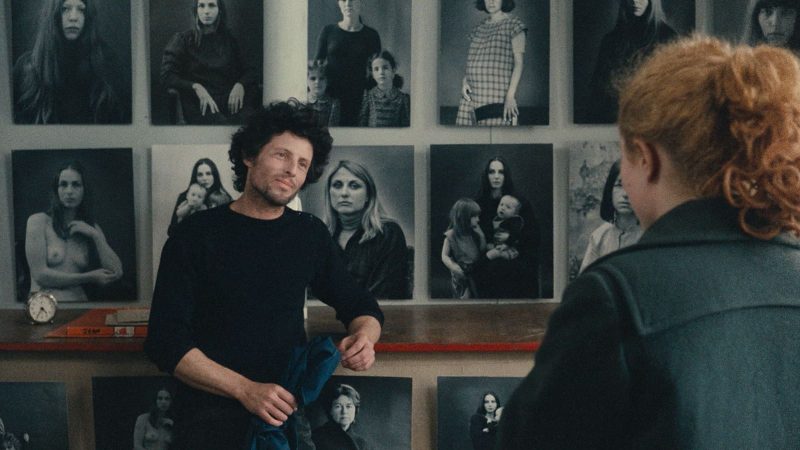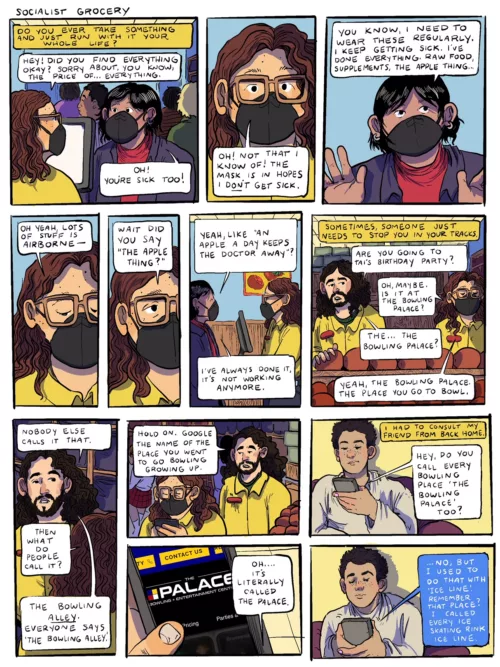
When I was a teenager, all bright eyed and bushy tailed for a swift revolution, I started to get involved in movement work. I thought that, for me, it was through activism/organizing that I could dedicate my life to liberation. In the helms of burnout, movement, heartache, and loss of hope, I thought to myself “when have you ever truly felt free, even if just for a moment?” While finding those moments of freedom within myself, I also found my friends, (or maybe that those brief moments were because of them). I was coming back to things I already knew, people who were already there, and those delicious moments of pure joy with my friends that I would play over and over again in my head. I did not grow up with god, but I grew up cultivating complex deep friendships. Since I was a kid, I’ve known that I can be overwhelmed by love, feeling it so deeply in a way that at times was overwhelming. I realized that it is something spiritual.
To me, friendship is god. When I’m in my head with it I see these iridescent strings anchored in my chest that flow from me to my friends in all the places they are scattered throughout the world. These strands fray and tighten and loosen with the things we go through but I go about my life knowing they are there, and when I need to call on that love I just tug. It’s not all easy, friendship isn’t just love it is also despair, pain, and tragedy, nothing in life is without that. To me, there is simply no liberation without friendship, so I dedicate a large part of my life to honoring, celebrating, and advocating for this belief (that I am so glad I found).
Friendship is there even when it’s not it’s main plot point, or resounding theme. Friendship is widely overlooked and undervalued in our society, friendship researchers have theorized the many intentional institutional factors that may contribute to this, like “does capitalism really want us to be friends?” or, “does it know the strength of people when they have the strength and love of each other?” Since I’ve started writing these lists I knew I would cover friendship at some point, but I kept putting it off, knowing with how much I love friendship, that it would be hard to choose just four to five movies, and do this theme justice. So, in compromise with myself, this may just be the first of many friendship lists!

Bandes de filles / Girlhood (2015)
Céline Sciamma’s coming of age drama Girlhood comes full and deep. We follow Marieme, who has recently met a group of girls, who like her live in estate housing in the Parisian suburbs. These young working class black girls are friends and comrades in fighting against the misery that tries to steal their adolescence, while proudly rocking that “scary hot cool girls” vibe. They do fun things like dance, skip school, reclaim space they deserve, and just hang out hard. They are not to be fucked with and are a bunch of sweethearts trying to survive while making fewer compromises than the world requires of them. Marieme is constantly evolving, her hair, her face, or her appearance in some way. We see her confusion, the ways that growing up can still be lonely even if you have friends. It’s really intense to be in your adolescence where so much of your autonomy is taken from you, and then being thrown into the world real quick. I think friendships have a weighted influence in your life at that time. That, unfortunately, often changes as people get older. Girlhood is about more than just friendship, but that strengthens its representation of it. Friendship exists within everything, and does not come without everything else that exists. The friend I am is influenced by who I have always been and my experiences that have molded me. Girlhood also reminds us that class, gender, race, sexuality, education, the whole lot of it, are part of our relationships to each other.
There’s a scene in Girlhood that I think of so fondly: the group of friends skip school and get a hotel room for the day, we see them scattered throughout the room, one’s in the bath, someone’s doing their hair, someone’s dancing, some on the bed doing this and that; later, blue light covers Marieme as she lays on the bed looking at her friends, singing and dancing to Rihanna’s Shine Bright Like a Diamond. She joins them and for two or so minutes we just watch them sing and dance together. You want them to be able to live in this moment forever, I wanted to yell at them “CHERISH THIS!! Years later you may lay in your bed and think back to this moment!!”… which is kind of funny because I’ve often sat in my bed and thought back to that scene, smiling for them.
Divines (2016)
Divines is a coming of age drama directed by Houda Benyamina. This was the filmmaker’s third feature film on the experience of identity for adolescent girls. It opens with portrait style snapchat videos of two friends doing fun stuff that teenagers do, like finding their way into buildings to giggle and watch the dancers. They are framed in the center of the black screen. It’s a playful youthful way of introducing us to our main characters, giving a quick bit of context about their friendship and their adolescence. Starting the film this way I found myself already developing an emotional connection to the characters. Dounia and Maimouna live in the Parisian Suburbs, both girls and their families are living in different experiences of poverty, they hustle together looking for an escape from their situations, and eventually they get involved with a local dealer who starts to send them off on jobs. Dounia is the driving force in this, and as you can surmise they get into some situations that compromise their safety and cause conflict in their friendship. Dounia and Maimouna are of different races, cultures, body types, etc, all of which affects their friendship and the things they go through. In early adolescence some of that is easier for kids to ignore but as you get older you just can’t. They are very different girls in their personalities and identities and those things clash and compliment one another, but it is obvious how much they cherish each other. They are one another’s escape from the hell they deal with.
I feel it’s important for me to say this film does not have a happy ending, I’m committed to celebrating Black Cinema that is not steeped in tragedy and pain. Divines is not full of pain but it is there and there is a tragedy that requires intentional digestion. Do not overlook this film because of that. It still deserves celebration, and attention, it’s an important modern display of adolescent friendship. I leave this film with that guttural feeling of just how precious life is, and how lucky we are to find friends to love and who love us HARD.
Linda Linda Linda (2005)
We have (yet again) another coming of age drama/comedy to the list! With a few days left before the school’s rock festival, a group of friends lose the guitarist of their band to an injury, which prompts their vocalist to quickly find a replacement. Luckily, a new Korean exchange student is quick to say yes, something she will come to question but ultimately stick with. They decide to cover songs from this band called “The Blue Hearts,” but all the songs are in Japanese, which poses a challenge for their new friend. Shiori Sekine (who plays bassist, Nozomi) is a member of a rock band called “Base Ball Bear,” which still makes music today. The other band members, guitarist Aki Maeda and drummer Yu Kashii, actually learned their instruments for the film! The soundtrack is sooo gooood and notable while you’re watching the movie. I kept remarking on how it really adds to this familiar 90s era vibe, only to learn the original instrumental compositions were composed by James Iha of the Smashing Pumpkins, so no wonder. The soundtrack also includes songs played by the band in the movie, Paranmaum. They actually released an EP in 2005 of the covers they sang in the movie, so this movie band was also a real band for a moment!
I honestly like that there isn’t really a ton happening in this movie, we get to spend a lot of time with them getting ready for the concert, and getting to know each other becoming confidants and being angsty. As a teen I was way closer with my friends than my family, we would talk about all the real things with each other, testing the waters of opening up about our emotions. Being a teenger feels like everythings on 10, it’s a blessing to have friends to have fun with through that.
One Sings, The Other Doesn’t (1974)

Described by the filmmaker Agnès Varda as a feminist musical (I would note to others, like myself, who are not too fond of musicals that it’s on the “lite musical” side of things) One Sings, The Other Doesn’t is about the friendship between two women named Pauline and Suzanne. Two estranged women reconnect through an abortion, and then abortion reconnects them again at a rally outside a courthouse. They spend years in different parts of Europe, the narration is a combination of their letters and our third party narrator Varda, summarizing time passed and guiding us back and forth between their lives. The beginning of their friendship was brief but they experienced so much together in that short time. Pauline helping Suzanne get the money for the abortion, fighting with her parents about it and leaving home, leaving school. Big life things happened to them both in that time which can draw people in closer together (not always in the healthiest ways) but they weren’t codependent trauma bonding- there was already this enamoration building. They are very different but very similar women, who have been alienated in their own ways for wanting to be more than society’s expectations of them as women.
I feel this film does a good job of showing the ways you may be 20 something, thinking you will never do xyz because you don’t want to inherently assimilate to the societally acceptable way of living, so you automatically say “fuck that i’m never gonna do that.” But years may go by and theres a reluctant realization you actually do want this thing, and that it’s more important to listen to what you actually want to do (not what society expects you to do).
I love the way Pauline and Suzanne pine for each other, the way they talk about their love to others in their lives. People close to them will know of this friendship even if they haven’t met, I appreciate that. It’s like how a friend who never met your sister may ask how your sisters are doing and genuinely hope they are well because they know that person is your loved one and that relationship matters to you.
Kahne-ye doust kodjast?/ Where Is The Friend’s House? (1987)
The first film in Abbas Kiarostami’s Koker trilogy which gets its name from the village where all the films are set Koker, Iran. Where Is The Friends House follows young Ahmed, throughout his day’s quest to return his classmate’s notebook. Ahmed knows how serious the potential repercussions are, this could be an expulsion as it wouldn’t be the first time Mohammed Reza was without his notebook. Once Ahmed realizes the accident, he sets off on this day’s journey to the neighboring town in hopes of finding Mohammed. Since he is unfamiliar with this town, and doesn’t have an address for him, Ahmed roams around and tries to ask the townsfolk for directions. In doing this people send him in all sorts of directions, giving him misinformation. I got really frustrated with the adults many times, yelling at the screen,” HE’S TALKING CAN YOU JUST LET HIM FINISH…. WHY AREN’T YOU LISTENING!!?!?”. You really feel for how overlooked kids are, from townspeople not taking Ahmed seriously when he’s asking for directions, and his mother thinking he doesn’t want to do his homework when really just wants to prevent Mohammed from getting in trouble.
I like that the film encapsulates an entire day, we start with them at school in the morning, home in the afternoon, and then spending the rest of the day with Ahmed on his search around town. I admire that he and Mohammad aren’t really close friends, maybe hadn’t called each other friends yet, and this may be the beginning of that. Where is the Friends House reminds us, simple is powerful, a small gesture can be so moving and to not overlook the wisdom and compassion of children, they are our teachers too.









